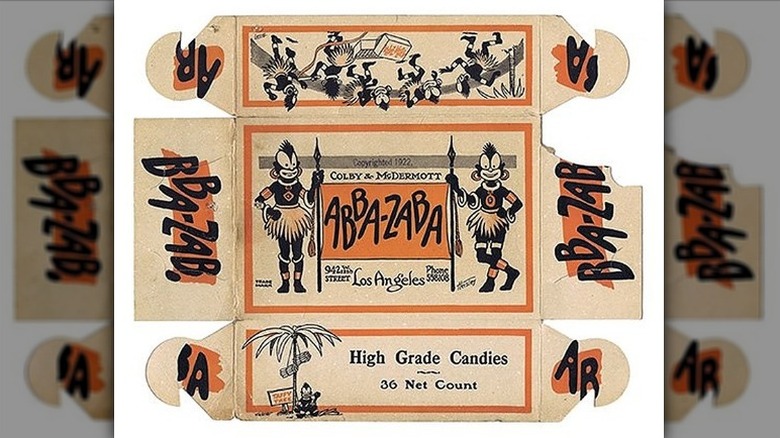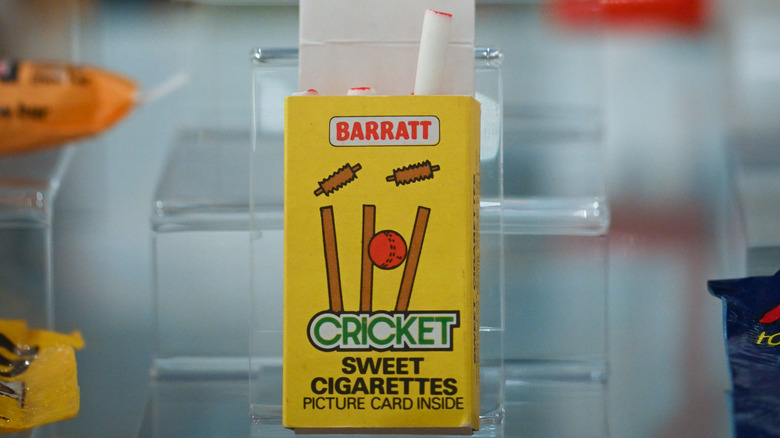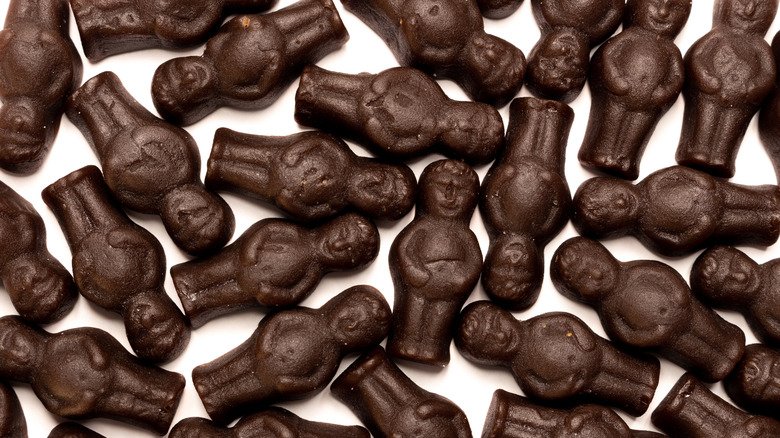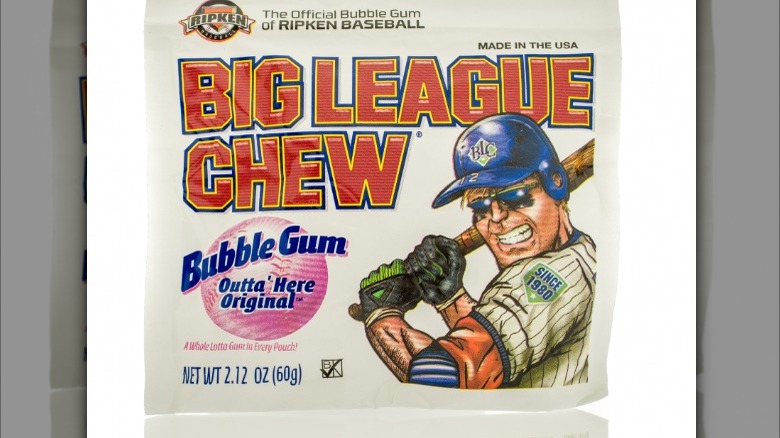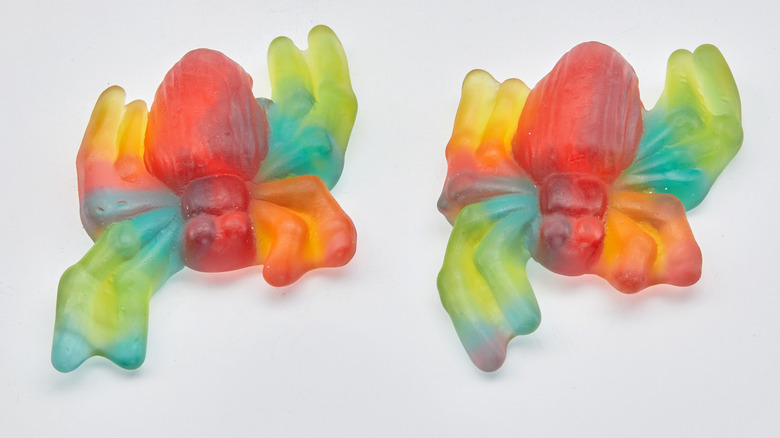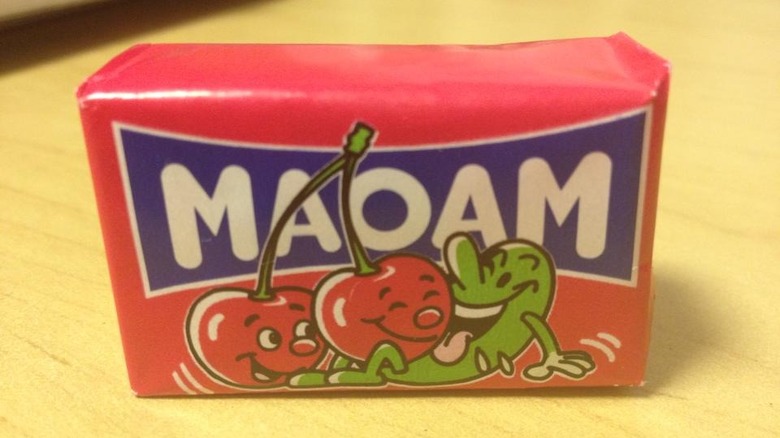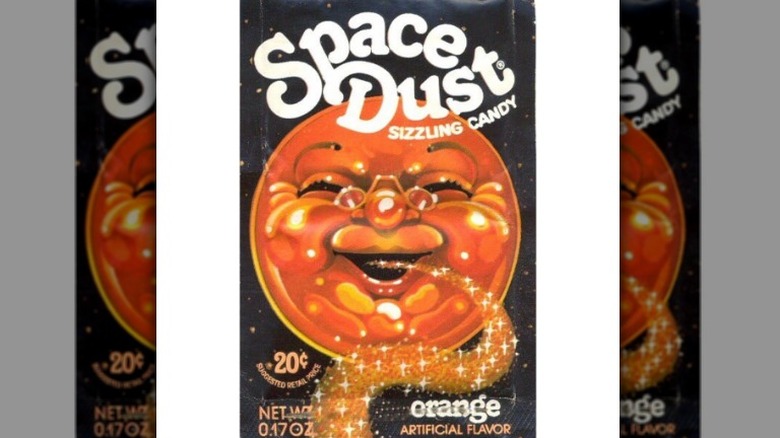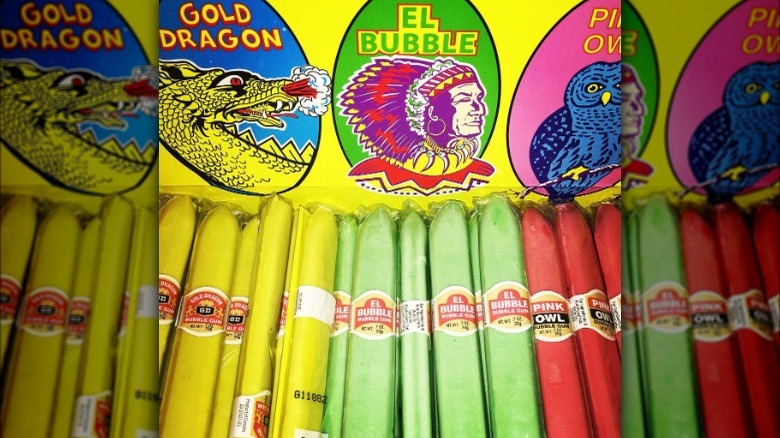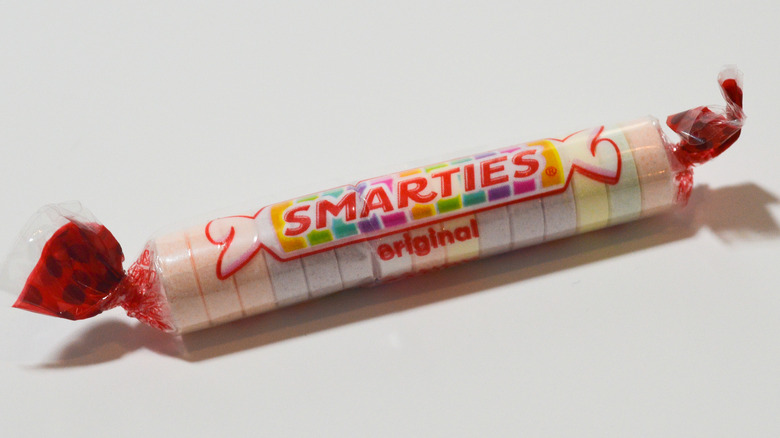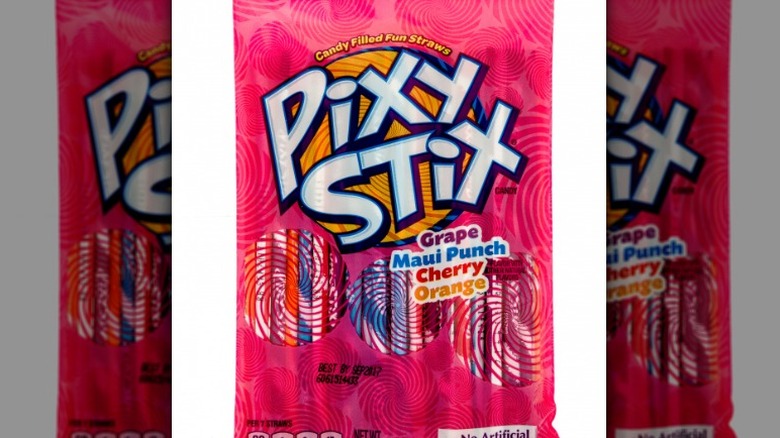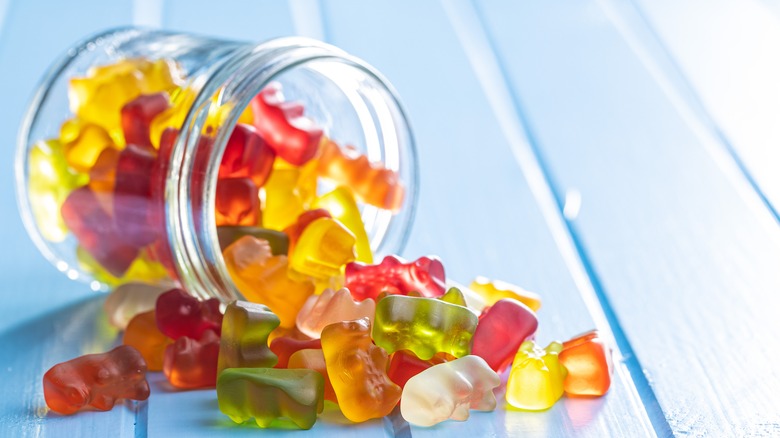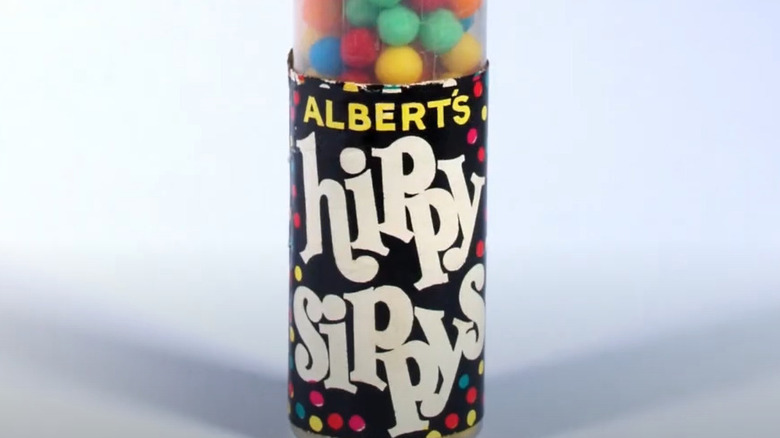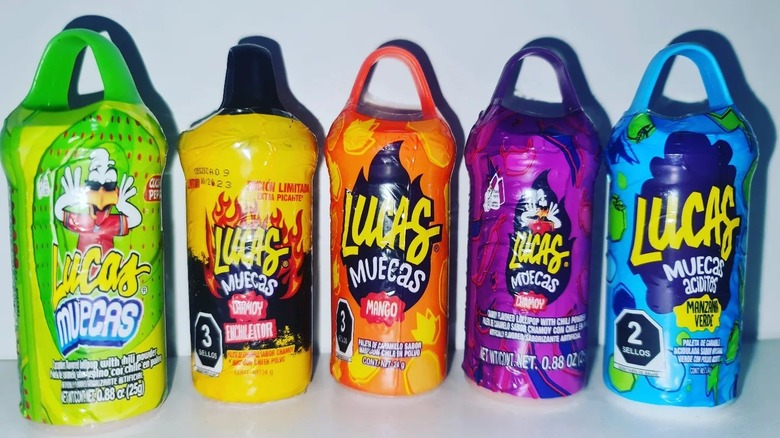Old-School Candies That Were Seriously Controversial
The modern era has more variety and accessibility than ever before, including the ability to order food right to your door and unlimited options on store shelves. Despite this, generations who grew up in the 20th century often feel that some aspects were just better "back then." The idea of popping over to the corner store to buy a candy bar for five cents is as nostalgic as it gets.
Although retro candies were charming and delicious for the most part, some of them are better left in the past. As it turns out, the history of candy has some dark roots; some of the most popular treats of the 1900s wouldn't have even made it on shelves in the current day. Along with racist wrappers and slogans, some old-school candies were viewed as encouraging drug use.
From sweets shaped like cigarettes to treats named after drugs, there's no shortage of candies created in the last century that wouldn't be deemed politically correct today. Here are the old-school candies that were seriously controversial in a number of ways.
Abba-Zaba
Abba-Zaba candy bars were a popular sweet with a chewy texture and peanut flavor. The Colby & McDermott Candy Company was intent on producing candy with both peanut butter and taffy, and it brought this vision to life when it invented the bars in 1922.
Although it succeeded in creating a popular and delicious candy bar, the company had room for improvement when it came to its packaging. The wrappers containing the bars were deeply offensive, depicting two savage-like people of color holding spears. The figures on the package wore grass skirts and large gold pieces of jewelry, fulfilling the stereotype of an African tribesperson.
Unfortunately, these wrappers were sold for a few decades before they were changed. In the 1950s, a new packaging with a yellow and black checkered design was released. Although it's been about 70 years since these old-school candies were sold with the original design, it's hard to forget that candy in such an offensive wrapper could be found in shops for decades.
Candy Cigarettes
When one thinks of old-school candies that caused a stir, Candy Cigarettes immediately come to mind. Cigarettes have been around since the 19th century and were first marketed to the wealthy upper class in Europe. Eventually, their popularity spread to include the wider public. In the 1930s, candy makers capitalized on the moment, creating Candy Cigarettes for children.
Mimicking adults has always been a pastime for kids, from playing house to holding fake weddings. When Candy Cigarettes were invented, kids played along, holding the sugary cigarettes in their mouths while pretending to be movie stars. Despite their children's enthusiasm, parents were less excited about the sweet, and they raised concerns about the message that Candy Cigarettes were sending to their offspring, according to Northeast News.
Due to the preoccupation that candy cigarettes would desensitize children to smoking, the treat was banned in North Dakota from 1953 to 1967, and most manufacturers had changed their packaging to exclude the word "cigarette" by the '70s. However, candy cigarettes remained on the market until 2009 when they were finally banned by the Food and Drug Administration (FDA).
Heide Chocolate Babies
We're accustomed to animal-shaped candies, like gummy bears and worms, which add cuteness to the experience of eating a sweet treat. However, in the 1940s, one confectioner took this trend too far by creating candies shaped like little babies. German immigrant Henry Heide, known for his popular candies, made Chocolate Babies after perfecting another iconic treat, Jujyfruits.
Although one can assume that the candy connoisseur had the best of intentions with his chocolatey treats, it's hard to ignore the racist undertones of babies made of chocolate. These treats were all the rage among chocolate-loving children, but the fact that they looked like black babies was an issue.
As explained in April Merleaux's blog post "The Subtlety of the Sugar Babies," the U.S. candy industry has a penchant for creating edible black and brown bodies. From caramel to chocolate, sweets have been used to promote subtly racist and dehumanizing messages, encouraging the idea that black bodies exist for consumption. Heide's Chocolate Babies are just one example of this.
[Featured image by Samuel Wiki via Wikimedia Commons | Cropped and scaled | CC BY-SA 1.0]
Big League Chew
Baseball has long been known as America's favorite pastime, and in the 20th century, many children grew up idolizing the players they saw on the field. Kids from the '80s will have fond memories of Big League Chew, the baseball-themed gum invented by pitcher Rob Nelson. Nelson came up with the idea for chewing gum that looked like tobacco in the late '70s.
As he explained in an interview with Esquire, he was inspired by a teenage baseball player who ate pieces of licorice chopped up to look like chewing tobacco. This got Nelson thinking about a product that could make baseball players "look cool" without the negative health effects of chewing tobacco. Eventually, Nelson brought his concept to fruition with the invention of Big League Chew. The gum gave kids the chance to mimic their baseball-playing idols while they played Little League.
Still, parents were uncomfortable with the idea of their kids pretending to chew tobacco. Big League Chew earned the reputation of being a potential precursor to tobacco use. Harvard public health researcher Gregory Connolly reports that research suggests children who buy candy versions of cigarettes are more likely to eventually try the real deal (via Chicago Tribune). Although baseball-playing kids loved Big League Chew, this all-American candy caused a great deal of controversy among adults.
Sloche Gummy Spiders
Few old-school candies were as offensive as Sloche Gummy Spiders. Sloche is a brand produced by Couche-Tard, a Canadian convenience store. This brand is known for its out-there packaging, which grabs the attention of consumers with its unconventional and at times offensive depictions. For example, some wrappers show animals dying in various ways, from being hit by cars to drowning. Although these wrappers are distasteful, none of them caused an uproar quite like Sloche's Gummy Spiders.
The strawberry-flavored spider-shaped gummy candies were contained in a packaging that depicted an angry-looking black man with a gold tooth, earrings, and a spider on his head that looked like dreadlocks. This picture played right into racist stereotypes of black men being aggressive, and the public immediately protested the problematic packaging.
In response, the company donated $18,000 to a group for black youth and wrote a public letter in which it grudgingly explained its intentions behind the offensive packaging. Although no apology was made, Couche-Tard agreed to discontinue the Sloche Gummy Spiders.
Maoam Candy
Most vintage candy that has offended the public over the years has been due to racist undertones or a similarity to drugs. When it comes to Maoam, this fruity chewy Haribo candy from the UK caused a stir for a different reason. Maoam didn't encourage children to try drugs, but it did expose them to lewd packaging. Although you might see a simple depiction of fruits having fun at first glance, upon closer inspection, there's more at play.
German candy maker Edmund Münster came up with the idea of making fruity chewy candies in 1930, and a year later Maoam was on the market. The candies were a hit, but their controversial wrappers showed pictures of fruits like lemons, limes, and cherries engaging in sexual activity. Although the notion of sexual fruits might seem unlikely, both their positioning and gleeful expressions make it clear. We're not sure what Münster was thinking when he decided to design the packages this way, but parents were not happy to discover their children enjoying candy with such inappropriate images (via Daily Mail).
Space Dust
Few candies are as popular and joy-inducing as Pop Rocks. The sweet taste combined with the satisfying feeling of the rocks popping on your tongue is hard to beat. General Foods created this yummy confection in the late '70s, and it was an instant hit. After a couple of years, the company produced another popular sweet treat called Space Dust, which was essentially Pop Rocks in powder form.
Space Dust came in packages with a whimsical picture of a happy moon wearing glasses and breathing in a sparkly substance, presumably Space Dust. For a brief moment in time, this new treat was a socially acceptable and beloved candy. However, as much as the kids loved this sweet powdery goodness, it didn't take parents long to realize that it looked and sounded eerily like the drug Angel Dust.
After noticing this similarity, parents complained that kids would be led to use the real drug. To appease them and avoid further criticism, General Foods changed the candy's name to Cosmic Candy. However, the rumor mill continued to spin, and the story of a child who died upon consuming the powder paired with soda came to light. Although it's unlikely that the candy ever posed any true danger, this didn't stop it from eventually being discontinued.
Candy Cigars
Candy Cigars became popular in the '50s and '60s as a baby shower favor. Interestingly enough, cigars have a history of being associated with birth, as they used to be a token of celebration for fathers of newly born babies. In the early 20th century, cigar companies saw the opportunity to expand sales and began creating cigars announcing the gender of a baby. Fathers could now gleefully give out cigars reading "It's a girl!" in celebration of their new child.
Confectionaries eventually caught wind of the trend and created Candy Cigars, which became a staple of baby showers. Pink ones advertised the birth of a girl and blue ones were given for newborn boys, making them ideal for gender reveal parties as well.
Along with being a party favor at baby showers, bubble gum cigars were marketed for children too. The sweet treats were shaped like the real deal, and some companies even added powdered sugar to the wrappers to mimic the effect of smoke when kids blew on them, allowing children to pretend they were smoking cigars. As fun and innocent as these candies were, the popularity of this treat didn't last long. Parents soon worried that smoking fake cigars would desensitize children to the dangers of smoking, and the sweet treat received increasing international criticism.
Smarties
Although Smarties are still widely popular in the present day, they were first created back in 1949 by Edward Dee, a British immigrant who dreamed of making candy. These sweet rolls are a classic among kids, beloved for their sweet taste, satisfying texture, and pastel colors. Billions are currently produced in both the United States and Canada, though they go by the name Rockets for our neighbors to the north.
It's hard to imagine any controversy sprouting up surrounding these wholesome and well-loved sweets. However, this old-school candy has had its own share of drama and upset due to the way children began consuming it. Rather than eating individual discs as intended, middle school children experimented with crushing and snorting them. This could lead to significant health concerns and the risk of choking (via Michigan Live). When they caught on, adults across the country became deeply concerned, leading schools to ban the popular sweet treat.
Pixy Stix
Pixy Stix has been around since the 1930s when creator J. Fish Smith first created a sweet powder to add to water called Frutola. When it became clear that kids were more interested in eating the powder on its own, he switched the product's name to Fruzola and added a spoon for scooping. The kids continued enjoying the sugary powder until a few decades later, when Sunline Inc. decided to package the colorful powder into long sticks, naming them Pixy Stix.
As innocent as this vintage candy may seem, Pixy Stix has raised concerns similar to those surrounding Smarties. Rather than pouring the powder into one's mouth as intended, middle school students have long been known to snort or smoke it, imitating drug use. The behavior has worried adults who think that it could lead kids down a dark path of substance use.
Pixy Stix also has a history of being used inappropriately in beauty pageants, according to Huffington Post. This has become so common that the candy has been nicknamed "pageant crack" and is used to provide energy and motivation to young competitors. Mothers have received criticism and been accused of drugging their children, but it's unclear whether the habit continues.
Haribo Gummy Bears
Haribo Gummy Bears are as old-school and lovable as it gets, however, their history has some rough spots. This classic treat was invented back in 1920 by German confectioner Hans Riegel Sr., and its success has grown exponentially since then. Gummy Bears are currently available in over 100 countries and have been a favorite for over a century.
Unfortunately, the company has a checkered history when it comes to its labor force. At the start of the 21st century, Haribo chose not to join Remembrance, Responsibility and the Future, a foundation whose purpose is to make amends to people who were obligated to work for German companies during World War II. Although there is no evidence that Haribo was one of the original companies involved, its refusal to join this foundation after the war was not a good look.
Then, in 2017, a documentary suggested that Haribo was using the labor of slaves in Brazil to produce carnauba wax, a key ingredient of the beloved gummies. No specific evidence was ultimately found to confirm the accusation, but it's hard to ignore such problematic rumors.
Hippy Sippy
Most candy lovers haven't heard of Hippy Sippy, which speaks to how quickly the candy was discontinued after being created. It was invented in Japan and brought to the United States in the late '60s, only to be recalled by the FDA by 1969. Although the '60s and '70s were an age of experimentation and freedom in many ways, this open mindset didn't translate to the toy and candy industry, which became clear soon after Hippy Sippy was put on shelves.
This vintage candy caused controversy for its blatant imitation of hard drugs. The treat came in a container shaped like a hypodermic needle or syringe, and the package was labeled with phrases like "Hippy Sippy Will Try Anything" and "Happiness Lives." The protests began soon after these controversial candies were put on shelves, as parents across the country were appalled that their children were consuming candy that came in fake hypodermic needles. Due to parental concerns and the FDA's intervention, Hippy Sippy didn't last long on the candy market.
Lucas Mexican Candy
American candy is typically sweet or sour, whereas candy produced in other countries often includes other taste profiles. Mexican candy is beloved for its spiciness, bringing an extra zing to the usual sweetness. Lucas Mexican Candy is a popular candy company that was started by brothers Hugo and Alejandro Martinez in the '80s.
Their first product was "Rico Pelo Loco," a treat made from tamarind fruit that was immediately beloved throughout Mexico. The Martinez brothers soon created the Lucas brand, which represented "Lucas Acidito," a citrus chili powder. Eventually, the company was bought by Mars but it continues to create Lucas products.
Despite its widespread popularity and success, the Lucas brand has had dark spots in its history as well. According to Chicago Tribune, in the early 2000s, four products were discovered to have high levels of lead. As a result, Lucas Limon, Super Lucas, Lucas Acidito, and Lucas Limon Con Chile were immediately removed from shelves by health departments across the country.

